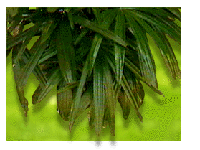Rhapis Palms are great as indoor plants and like most good indoor plants they come from a sub-tropical to tropical rainforest in south-east China where there isn’t much natural light. There are two sorts of Rhapis palms suitable for indoor living.
Plant details
Common Name: Lady Palm
Botanic Name: Rhapis excelsa
Description: This is a multi-stemmed dwarf fan palm from southern China. The leaves are divided into five to 12 blunt-ended pieces and its stems are clothed in a brown fibrous sheath like hessian. The palms are dwarfed to as little as 25cm (10″) in China by confining the roots and pulling off the sheaths as they appear. Lady Palms are quite cold tolerant and will grow well in frost-free temperate climates. They are most successful in semi-shaded parts of the garden and indoors. The Lady Palm is slow growing and so can remain in the same pot for many years.
Common Name: Slender Lady Palm
Botanic Name: Rhapis humilis
Description: This is similar to the Rhapis excelsa but the leaves are divided into eight to 22 pieces which are narrower and pointed. It also has a fibrous sheath covering the stems but it is finer and narrower than the Rhapis excelsa. When planted in the ground the clumps can extend to more than 2m (7′) across and 4m (13′) high.
Best climate: Subtropical and tropical climates and around the coast of mainland Australia.
Worth a try: Rhapis will withstand frost to -5°C but need shelter and warmth during the day. They are not happy where both night and day temperatures are cold.
Care:
- easy to grow
- slow growing, so does not need repotting regularly
- if grown indoors will benefit from occasionally being put outside in the rain, providing the conditions are mild and they’re kept out of direct sunlight
Availability
Rhapis Palms are available from most nurseries throughout Australia. They are relatively expensive because of their slow growth and range in price from $30 to $50 for a 20cm (8″) pot.



